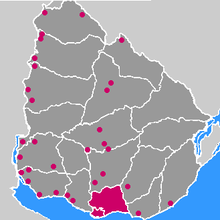Viticulture in Uruguay
As in many countries in South America, it was the Spaniards in Uruguay who imported viticulture at the end of the 18th century . But the very numerous in Uruguay Italian immigrants cultivated wine . Commercial wine production began around 1870.
Today 90-100,000 hectoliters are produced on around 10,000 hectares in 270 mostly smaller farms. The largest growing areas are around the capital, Montevideo, in the Canelones department , where around 60% of production occurs. Most of the smaller areas are along the Uruguay River and the Río de la Plata . The climate in Uruguay is humid and subtropical-warm, but due to its proximity to the sea and the Río de la Plata, the main cultivation area is well ventilated, similar to the Médoc .
The oldest grape variety in Uruguay is Tannat , which was imported from the French Basque Country by Pascual Harriague in 1875 .
Other grape varieties are Merlot , Cabernet Sauvignon , Cabernet Franc and Syrah (red wine) as well as Chardonnay , Sauvignon Blanc , Gewürztraminer , Pinot Grigio , Chenin Blanc , Moscatel , Frontignan , Riesling , Semillón , Muscatel Ottonel and Torrontés (white wine).
literature
- Jancis Robinson : The Oxford Wine Lexicon . Hallwag, Gräfe and Unzer, Munich 2006, ISBN 978-3-8338-0691-9 .

